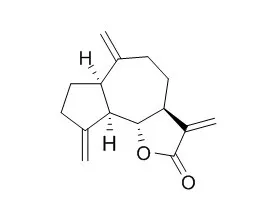| Description: |
Dehydrocostus lactone (DHE), a natural sesquiterpene lactone, inhibits IKKβ, Wnt/β-catenin activity, IκBα phosphorylation and degradation, coactivators p300 recruitments and p50/p65 NF-κB nuclear translocation, and their DNA binding activity on COX-2 promoter. DHE has anti-inflammatory, antioxidant, anti-ulcer, immunomodulatory and anti-tumor properties, it can against osteoblast damage induced by AMA and cervical cancer. DHE exhibits strong larvicidal activity against A. albopictus with LC(50) values of 2.34 ug/ml.
|
| In vitro: |
| Phytother Res. 2015 May;29(5):680-6. | | Inhibition of Wnt/β-Catenin Pathway by Dehydrocostus Lactone and Costunolide in Colon Cancer Cells.[Pubmed: 25625870] | Abnormal activation of β-catenin has been reported in 90% in the sporadic and hereditary colorectal cancer. The suppression of abnormally activated β-catenin is one of the good strategies for chemoprevention and treatment of colorectal cancer.
METHODS AND RESULTS:
In this study, we have isolated two main compounds from root of Saussurea lappa, Dehydrocostus lactone (DCL) and costunolide (CL), and investigated their anti-colorectal cancer activities. DCL and CL suppressed cyclin D1 and survivin through inhibiting nuclear translocation of β-catenin. They also suppressed the nuclear translocation of galectin-3 that is one of the coactivators of β-catenin in SW-480 colon cancer cells. Furthermore, DCL and CL suppressed proliferation and survival of SW-480 colon cancer cells through the induction of cell cycle arrest and cell death.
CONCLUSIONS:
Taken together, DCL and CL from root of S. lappa have anti-colorectal cancer activities through inhibiting Wnt/β-catenin pathway. | | Planta Med. 2012 Nov;78(16):1749-56. | | Effect of costunolide and dehydrocostus lactone on cell cycle, apoptosis, and ABC transporter expression in human soft tissue sarcoma cells.[Pubmed: 23047249] | Human soft tissue sarcomas represent a rare group of malignant tumours that frequently exhibit chemotherapeutic resistance and increased metastatic potential following unsuccessful treatment.
METHODS AND RESULTS:
In this study, we investigated the effects of costunolide and Dehydrocostus lactone, which have been isolated from Saussurea lappa using activity-guided isolation, on three soft tissue sarcoma cell lines of various origins. The effects on cell proliferation, cell cycle distribution, apoptosis induction, and ABC transporter expression were analysed. Both compounds inhibited cell viability dose- and time-dependently. IC50 values ranged from 6.2 μg/mL to 9.8 μg/mL. Cells treated with costunolide showed no changes in cell cycle, little in caspase 3/7 activity, and low levels of cleaved caspase-3 after 24 and 48 h. Dehydrocostus lactone caused a significant reduction of cells in the G1 phase and an increase of cells in the S and G2/M phase. Moreover, it led to enhanced caspase 3/7 activity, cleaved caspase-3, and cleaved PARP indicating apoptosis induction. In addition, the influence of costunolide and Dehydrocostus lactone on the expression of ATP binding cassette transporters related to multidrug resistance (ABCB1/MDR1, ABCC1/MRP1, and ABCG2/BCRP1) was examined using real-time RT-PCR. The expressions of ABCB1/MDR1 and ABCG2/BCRP1 in liposarcoma and synovial sarcoma cells were significantly downregulated by Dehydrocostus lactone.
CONCLUSIONS:
Our data demonstrate for the first time that Dehydrocostus lactone affects cell viability, cell cycle distribution and ABC transporter expression in soft tissue sarcoma cell lines. Furthermore, it led to caspase 3/7 activity as well as caspase-3 and PARP cleavage, which are indicators of apoptosis. Therefore, this compound may be a promising lead candidate for the development of therapeutic agents against drug-resistant tumours. | | Parasitol Res. 2012 Jun;110(6):2125-30. | | Essential oil composition and larvicidal activity of Saussurea lappa roots against the mosquito Aedes albopictus (Diptera: Culicidae).[Pubmed: 22167373 ] | In recent years, uses of environment friendly and biodegradable natural insecticides of plant origin have received renewed attention as agents for vector control.
METHODS AND RESULTS:
The aim of this research was to determine larvicidal activity of the essential oil derived from roots of Saussurea lappa (Compositae) and the isolated constituents against the larvae of the Culicidae mosquito Aedes albopictus. Essential oil of S. lappa roots was obtained by hydrodistillation and analyzed by gas chromatography (GC) and GC-mass spectrometry (MS).
A total of 39 components of the essential oil of S. lappa roots were identified. The essential oil has higher content of (79.80%) of sesquiterpenoids than monoterpenoids (13.25%). The principal compounds in S. lappa essential oil were Dehydrocostus lactone (46.75%), costunolide (9.26%), 8-cedren-13-ol (5.06%), and α-curcumene (4.33%). Based on bioactivity-directed fractionation, Dehydrocostus lactone and costunolide were isolated from S. lappa essential oil. Dehydrocostus lactone and costunolide exhibited strong larvicidal activity against A. albopictus with LC(50) values of 2.34 and 3.26 μg/ml, respectively, while the essential oil had an LC(50) value of 12.41 μg/ml.
CONCLUSIONS:
The result indicated that the essential oil of S. lappa and the two isolated constituents have potential for use in control of A. albopictus larvae and could be useful in search of newer, safer and more effective natural compounds as larvicides. |
|






 Cell. 2018 Jan 11;172(1-2):249-261.e12. doi: 10.1016/j.cell.2017.12.019.IF=36.216(2019)
Cell. 2018 Jan 11;172(1-2):249-261.e12. doi: 10.1016/j.cell.2017.12.019.IF=36.216(2019) Cell Metab. 2020 Mar 3;31(3):534-548.e5. doi: 10.1016/j.cmet.2020.01.002.IF=22.415(2019)
Cell Metab. 2020 Mar 3;31(3):534-548.e5. doi: 10.1016/j.cmet.2020.01.002.IF=22.415(2019) Mol Cell. 2017 Nov 16;68(4):673-685.e6. doi: 10.1016/j.molcel.2017.10.022.IF=14.548(2019)
Mol Cell. 2017 Nov 16;68(4):673-685.e6. doi: 10.1016/j.molcel.2017.10.022.IF=14.548(2019)